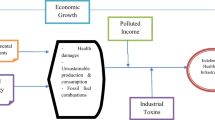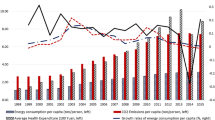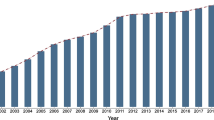Abstract
Vehicle exhaust emissions are identified as one of the main determinants of air pollution and play an important role in the environmental sustainable improvement of countries. This research utilizes a panel data of 30 Chinese provinces during the period between 1997 and 2012 to examine the existence of inverted U-shaped relationship between public healthcare expenditure per capita and private car ownership across geographical regions (east, middle and west China) employing panel generalized method of moments estimates for robust estimates. The findings also show the income per capita significantly and positively impacts on health expenditure per capita at the national level. The other results indicate that sulfur dioxide emissions and people over age 65 significantly increase healthcare expenditure per capita except the western region; soot emissions have a significantly positive impact on public health expenditure per capita for only the whole country and the western region; the number of doctors per capita may decrease public health expenditure per capita caused by environmental pollution. These results have important policy implications for promotion of new energy vehicles and for improving air quality and medical and health services.

Similar content being viewed by others
References
Akbar FA, Hossein G, Masoud S, Reza FA (2016) Health care expenditure and GDP in oil exporting countries: evidence from OPEC data, 1995–2012. Glob J Health Sci 8:93–98
Ambrey C, Fleming C (2014) Public greenspace and life satisfaction in urban Australia. Urban Stud 51:1290–1321
Amiri A, Ventelou B (2012) Granger causality between total expenditure on health and GDP in OECD: evidence from the Toda–Yamamoto approach. Econ Lett 116:541–544
Arellano M, Bond S (1991) Some tests of specification for panel data: Monte Carlo evidence and an application to employment equations. Rev Econ Stud 58:277–297
Bala B (2012) Causal nexus between public health expenditure and economic growth in four southern Indian states. IUP J Public Finance 7:7–22
Bekhet HA, Matar A, Yasmin T (2017) CO2 emissions, energy consumption, economic growth, and financial development in GCC countries: dynamic simultaneous equation models. Renew Sustain Energy Rev 70:117–132
Biresselioglu ME, Kilinc D, Onater-Isberk E, Yelkenci T (2016) Estimating the political, economic and environmental factors’ impact on the installed wind capacity development: a system GMM approach. Renewable Energy 96:636–644
Chaabouni S, Abednnadher C (2014) The determinants of health expenditures in Tunisia: an ARDL bounds testing approach. Int J Inf Syst Serv Sect 6:60–72
Chaabouni S, Zghidi N (2016) On the causal dynamics between CO2 emissions, health expenditures and economic growth. Sustain Cities Soc 31:413–416
Chen S, Chen T (2014) Air pollution and public health: evidence from sulfur dioxide emission of coal-fired power stations in China. Econ Res J 8:158–169
Chen X, Shao S, Tian Z, Xie Z, Yin P (2017) Impacts of air pollution and its spatial spillover effect on public health based on China’s big data sample. J Clean Prod 142:915–925
Çoban S, Topcu M (2013) The nexus between financial development and energy consumption in the EU: a dynamic panel data analysis. Energy Econ 39:81–88
Del Vecchio M, Fenech L, Prenestini A (2015) Private health care expenditure and quality in Beveridge systems: cross-regional differences in the Italian NHS. Health Policy 119:356–366
Edame GE (2014) Trends analysis of public expenditure on infrastructure and economic growth in Nigeria. Int J Asian Soc Sci 4:480–491
Fedeli S (2015) The impact of GDP on health care expenditure: the case of Italy (1982–2009). Soc Indic Res 122:347–370
Gerking S, Stanley LR (1986) An economic analysis of air pollution and health: the case of St. Louis. Rev Econ Stat 68:115–121
Haines A, Mcmichael AJ, Smith KR, Roberts I, Woodcock J, Markandya A, Armstrong BG, Campbell-Lendrum D, Dangour AD, Davies M (2009) Public health benefits of strategies to reduce greenhouse-gas emissions: overview and implications for policy makers. Lancet 339:1211–1212
Halicioglu F (2009) An econometric study of CO2 emissions, energy consumption, income and foreign trade in Turkey. Energy Policy 37:1156–1164
Halkos GE, Paizanos EΑ (2013) The effect of government expenditure on the environment: an empirical investigation. Ecol Econ 91:48–56
Hartwig J (2010) ‘Baumol’s diseases’: the case of Switzerland. SSRN Electron J 146:533–552
Khan HN, Khan MA, Razli RB, Sahfie AAB, Shehzada G, Krebs KL, Sarvghad N (2016) Health care expenditure and economic growth in SAARC countries (1995–2012): a panel causality analysis. Appl Res Qual Life 1:1–23
Kheirbek I, Haney J, Douglas S, Ito K, Matte T (2016) The contribution of motor vehicle emissions to ambient fine particulate matter public health impacts in New York City: a health burden assessment. Environ Health 15:1–14
Langrish JP, Li X, Wang S, Lee MM, Barnes GD, Miller MR, Cassee FR, Boon NA, Donaldson K, Li J (2012) Reducing personal exposure to particulate air pollution improves cardiovascular health in patients with coronary heart disease. Environ Health Perspect 120:367–372
Lelieveld J, Evans JS, Fnais M, Giannadaki D, Pozzer A (2015) The contribution of outdoor air pollution sources to premature mortality on a global scale. Nature 525:367–384
Li P, Zhao P, Brand C (2018) Future energy use and CO2 emissions of urban passenger transport in China: a travel behavior and urban form based approach. Appl Energy 211:820–842
Liao H, Tang X, Wei Y-M (2016) Solid fuel use in rural China and its health effects. Renew Sustain Energy Rev 60:900–908
Mao MC, Huang JY (2016) Research in the effects of environment pollution and public services on health expenditures-based on the threshold of the Chinese provincial panel data analysis. Collect Essays Finance Econ 203:87–104
Mehrara M, Sharzei G, Mohaghegh M (2011) The relationship between health expenditure and environmental quality in developing countries. J Health Adm 14:79–88
Ou YM, Zhou SF (2014) Industrial soot emissions and health care spending empirical study. Ecol Econ 30:179–181
Pao HT, Tsai CM (2010) CO2 emissions, energy consumption and economic growth in BRIC countries. Energy Policy 38:7850–7860
Patankar AM, Trivedi PL (2011) Monetary burden of health impacts of air pollution in Mumbai, India: implications for public health policy. Public Health 125:157–164
Preker AS, Adeyi OO, Lapetra MG, Simon DC, Keuffel E (2016) Health care expenditures associated with pollution: exploratory methods and findings. Ann Global Health 82:711
Qi LS (2008) Interrelationship between growth, environment and population health: an empirical analysis based on China’s provincial data. China Popul Resour Environ 18:169–173
Qiu JJ, Li CZ (2014) The relationships of age, sex structure and household consumption: evidence from provincial dynamic panel data. China Popul Resour Environ 24:123–131 (in Chinese)
Qu WH, Yan ZJ (2015) The influence of environmental pollution, economic growth and healthcare services to public health based on China’s provincial panel data. Chin J Manag Sci 23:166–176
Qu WH, Yan ZJ, Qu GH, Maria I (2015) Household solid fuel use and cardiovascular disease in rural areas in Shanxi, China. Iran J Public Health 44:625–638
Qu WH, Xu L, Qu GH, Yan ZJ, Wang JX (2017) The impact of energy consumption on environment and public health in China. Nat Hazards 87:675–697
Richmond AK, Kaufmann RK (2006) Is there a turning point in the relationship between income and energy use and/or carbon emissions? Ecol Econ 56:176–189
Rohde RA, Muller RA (2015) Air pollution in China: mapping of concentrations and sources. PLoS ONE 10:e0135749
Shi H, Fan J, Zhao D (2017) Predicting household PM2.5-reduction behavior in Chinese urban areas: an integrative model of theory of planned behavior and norm activation theory. J Clean Prod 145:64–73
Teixeira AAC, Queirós ASS (2016) Economic growth, human capital and structural change: a dynamic panel data analysis. Res Policy 45:1636–1648
Uçak H, Aslan A, Yucel F, Turgut A (2015) A dynamic analysis of CO2 emissions and the GDP relationship: empirical evidence from high-income OECD countries. Energy Sources Part B 10:38–50
Wang KM (2011) Health care expenditure and economic growth: quantile panel-type analysis. Econ Model 28:1536–1549
Wang B, Nie X (2016) The health cost of economic development: sewage discharge and the mid-aged and elderly health in rural. J Financ Res 183:59–73 (in Chinese)
Wang C, Engels A, Wang Z, Wang C, Engels A, Wang Z (2017) Overview of research on China’s transition to low-carbon development: the role of cities, technologies, industries and the energy system. Renew Sustain Energy Rev 10:99–113
Yang JS, Xu J, Wu XJ (2013) Income growth, environmental cost and health problems. Econ Res J 59:17–29 (in Chinese)
Ye XQ, Li XL (2013) The effects of environmental quality and residents’ income on health expenditure: based on provincial panel data with cross-section dependence. Stat Inf Forum 28:2–46
Ye XQ, Xu J (2014) Demographic structure, environmental quality and resident expenditures on health. Chin Health Econ 33:48–50
Zhang Y, Guo Y, Li G, Zhou J, Jin X, Wang W, Pan X (2012) The spatial characteristics of ambient particulate matter and daily mortality in the urban area of Beijing, China. Sci Total Environ 435:14–20
Zhang S, Worrell E, Crijns-Graus W, Krol M, Bruine MD, Geng G, Wagner F, Cofala J (2016) Modeling energy efficiency to improve air quality and health effects of China’s cement industry. Appl Energy 184:574–593
Zhao XL, Fan CY, Wang YX (2014) Evaluation of health losses by air pollution in Beijing: a study based on corrected human capital method. China Popul Resour Environ 24:169–176
Acknowledgements
The authors would like to express their gratitude to colleagues who patiently reviewed this article. We gratefully acknowledge the financial support from Projects of Beijing Natural Science Foundation of China (No. 9152015), National Natural Science Foundation of China (No. 73171113), the second Shanxi planning office of philosophy and social science “Shanxi’s economic sustainable development mechanism under supply-side structural reform,” Youth Foundation of Shanxi University of Finance and Economics (No. QN2017-007), Shanxi education science 13th five-year plan (No. GH-16046), Research on philosophy and social science of institution of higher education (No. 20172206) and special award for on Shanxi University of Finance and Economics (No. ZX-201704). Sincerely appreciate Yong-Zou, Business School, Guilin University of Technology for her doing a lot of work during the revised paper. The authors are very grateful to the anonymous referees for their constructive comments and suggestions that have led to an improved version of this paper.
Author information
Authors and Affiliations
Corresponding authors
Rights and permissions
About this article
Cite this article
Qu, WH., Qu, GH., Zhang, XD. et al. Effects of private car ownership, economic growth and medical services on healthcare expenditure in China: a dynamic panel data analysis. Nat Hazards 93, 167–188 (2018). https://doi.org/10.1007/s11069-018-3294-z
Received:
Accepted:
Published:
Issue Date:
DOI: https://doi.org/10.1007/s11069-018-3294-z




